2020 has been a shit year for most of us here on Earth. But it may turn out to be a landmark year for science, and the search for life outside of Earth.
The search for extra-terrestrial life has mostly focused on Mars and the icy moons of the outer solar system.
For decades, the focus of the search for extraterrestrial life has focused on Mars, the outter solar system (such as the moon Titan and Europa), and searching for non-natural radio signals from other stars. But a recent review of data from the Pioneer 13 space probe has revealed that the probe detected one of the tell-tale indications of life in the atmosphere of Venus way back in 1978. The review of Pioneer 13's data was prompted by the recent discovery (by scientists using a land-based telescope) of a chemical called phosphine in the atmosphere of Venus. The findings were published in the journal Nature Astronomy a month ago, on September 14.
Phosphine is a class of gas that can be produced from atmospheric chemistry under high pressure, or as a by-product of anaerobic biology. Phosphine has also been detected in the atmosphere of gas giants such as Jupiter, where the incredibly high pressure and energy of Jupiter's interior atmosphere produces the compound, which then floats up to the upper atmosphere, where it reacts with other chemicals and oxidized (or dissolves). The atmosphere of Venus, however, lacks the higher pressure of Jupiter that would be continually-creating phosphine. As such, the chemical cannot be produced in Venus' atmosphere, in the quantities detected, by the same mechanisms that produce it on Jupiter. Another explanation is required, and the only other known way to produce this type of phosphine is through anaerobic biological processes. [More]
0cb58285-41a4-4391-8ff7-08dda812b29c|1|5.0
Tags:Venus, life, extraterrestrial, greenhouse gas, Pioneer 13, NASA, phosphine, Heinz Haber, Carl Sagan, Harold Morowitz, Sara Seager
The initial announcement of Star Trek: Discovery looked very promising. Unfortunately, the news has not been as good since then.
First of all, the first teaser showed some lackluster CGI effects, but I was willing to dismiss that as being evident of the show's early prouction. But then news kept getting worse. Bryan Fuller stepped down as the showrunner, CBS repeatedly stated that the show won't be an anthology (even though an anthology would be a great idea), and the show was delayed from January to March. Now it's been delayed again - this time indefinitely. The delays appear to be related with CBS's in ability to get its streaming service off the ground, delays in casting, and scheduling conflicts with those who have been cast.
But production has started, and the first teaser trailer has come out.
A behind the scenes teaser gives a look at uniforms, sets, possible ship redesigns, and the captain's chair.
The first thing that stood out to me is the tease of the new uniforms, which resemble a combination of the Star Trek: Enterprise uniforms, and the cadet uniforms from the rebooted Star Trek movies. But there's a huge flaw in this uniform: the breast badge is the delta shield. Since this is a prequel to the original series, this uniform is unlikely to belong to an Enterprise crew member, even though that delta shield was unique to the Enterprise in the original series.
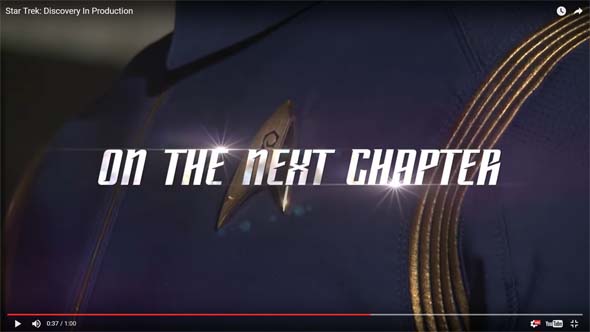
The Discovery teaser shows a delta shield badge on a pre-TOS uniform - which is a Star Trek faux pax.
In the Original Series, each ship, starbase, or installation had its own unique mission badges, similar to contemporary NASA missions. This was a detail that even Star Trek: Enterprise got right! But the Abrams reboot, and now the new Discovery series have broken with this detail, making the uniforms anachronistic within established series' canon.
Each ship, starbase, or installation in The Original Series had its own unique mission patch, inspired by NASA missions.
By the time of The Next Generation, Starfleet had adopted a single insignia for the use of its communicator badges, which was based on the Enterprise 1701's mission insignia. Of course, this badge was a piece of technology, rather than a simple patch on a shirt, so there could have been technical limitations that required the adoption of a single insignia.
UPDATE: FEBRUARY 10, 2017:
Since seeing the trailer and writing this post, it has come to my attention that I may have over-reacted to the insignia. The presence of this insignia may be a reference to the possibility that the lead character of the show is going to be the first officer from the original Star Trek pilot. This character was played by Majel Barrett (who later went on to protray Nurse Chapel), and this character was un-named, and was only called "Number One"). So this character would have previously served onboard the U.S.S. Enterprise with Captain Pike. Perhaps this insignia is on Captain Pike's uniform?
Either way, the fact that this insignia is still being used as the show's insignia bothers me, as the show is called "Star Trek: Discovery". The insignia for the show should be the Discovery's insignia, and the Discovery should have an insignia all its own. But this insignia is dangerously close to the original Enterprise's [More]
daf66755-c254-4474-af34-b9985da63c4e|1|5.0
Tags:Star Trek, Star Trek: Discovery, CBS, Paramount, Bryan Fuller, NASA, uniform, delta shield, mission patch, U.S.S. Discovery, anthology, Number One, Majel Barrett

I dropped the ball on this one. I often criticize Hollywood for not being willing to make genuine, hard science fiction movies anymore, and I begroan the continued bastardization of my beloved Star Trek and the dumbed down action flicks that Hollywood dared to put the "Star Trek" title on. The studios say that science fiction don't make enough money. Apologists say that casual audiences are too dumb and impatient to sit through any kind of slow-developing, cerebral movie. Ironically enough (despite my own frequent cynicism) I think both these apologetics are too cynical and don't give audiences enough credit. I firmly believe that if the studios make a good movie, the audiences will go see it, especially if it's properly marketed.
So when a thoughtful, science fiction movie like The Martian comes out, I try to make a point of spending my money to see it in order to show my support for the continued development of the genre. I made a point of seeing Gravity, despite that movie appearing to be little more than space destruction porn and iMax eye candy. I also made sure that I saw last year's Interstellar. And both of the Planet of the Apes reboots have been surprisingly excellent. Unfortunately, I lost track of the release date of The Martian and missed seeing it on opening weekend (one of Hollywood's biggest metrics of a movie's success). I also wasn't able to see it the week after, or the week after that due to my weekends being consistently busy. It was over a month before I finally put my foot down and said "I'm seeing this movie now! No more delay!". And then I went and saw it twice in that same weekend.
Fortunately, the rest of the country vindicated me by heaping dump trucks full of praise on the movie and putting their butts in the theater seats to keep The Martian at the number 1 spot in the box office for almost the entire month of October (only briefly falling to number 2 for one week behind Goosebumps - really?). It finally took an upteenth sequel to a beloved franchise to topple The Martian when Spectre (which I also saw this weekend) held the top spot for two weeks in a row. The movie itself is earning Oscar buzz, and Matt Damon seems to be the current favorite for "Best Actor". So there you have it, Hollywood: make a good sci-fi movie, and they will come, and they will love it.

Matt Damon's character is charming and easily has the audience rooting for him against all odds.
And the movie is absolutely fantastic! It's ambitions are closer to Apollo 13 than to 2001: A Space Odyssey. It's a very believable, down-to-earth, science fiction film, the events of which feel like they could happen tomorrow. Matt Damon's performance is absolutely charming as a NASA astronaut stranded on Mars and presumed dead when his team is forced to evac due to a violent sandstorm... [More]
07512981-d696-4a06-9ee6-d639a967a128|0|.0
Tags:The Martian, Matt Damon, Ridley Scott, science fiction, Mars, space, NASA, astronaut, Ares, Pathfinder, optimism, Oscar
NASA's New Horizons spacecraft set a major milestone for human space exploration earlier this week. Its approach of Pluto means that every solar body that is now - or ever has been - considered a "planet" has been visited by at least one NASA space probe. The probe was launched in January of 2006 (back when Pluto was still a "planet"), and it will continue out beyond Pluto and into the mysterious Kuiper Belt to continue its exploration of the solar system.
In the meantime, the probe has sent back months-worth of high-resolution images and scans for NASA scientists to study. The early results are already full of surprises.
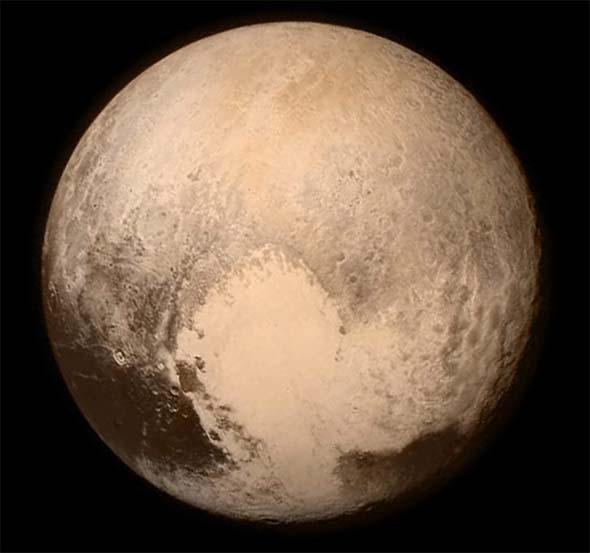
New Horizon's first, high-res photograph of Pluto (July 14, 2015).
Pluto - it turns out - is not the old, craggy, cratered world that many scientists expected it to be. In fact, it appears quite young, with tall, rocky mountains and nary a single impact crater. This is surprising considering the body's proximity to the Kuiper Belt, which contains numerous asteroids, and other small, rocky bodies left over from the formation of the solar system.
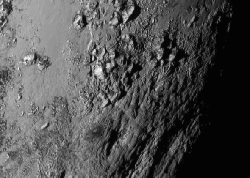
Large mountains were found on Pluto.
The probe also found possible evidence of frozen water. Frozen nitrogen and methane were expected, but early photographs suggest that frozen water may also make up a large portion of Pluto's crust. This is exciting for scientists because the presence of water (even in frozen ice form) is a possible indicator of life. There doesn't appear to be any liquid water (at least not yet), so the prospects for life are much better on Jupiter's moon Europa (which may have underground liquid oceans warmed by subterranean vents), or Saturn's moon Titan (which has a dense atmosphere and possible liquid surface water). But it at least adds Pluto to the list of possible targets of further study.
New Horizons was actually making discoveries long before it reached Pluto. In 2007, it captured video of a massive volcanic eruption on Jupiter's moon Io. It was a pretty spectacular sight to behold.
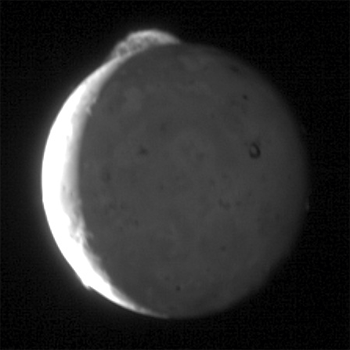
A five frame video of a massive volcanic plume on Jupiter's moon Io (taken in 2007).
As an interesting piece of trivia: the New Horizons craft also contains the cremated remains of Clyde Tombaugh, the man who first discovered Pluto in 1930. He had requested that his ashes be sent to space. Not only did NASA oblige, but they send his ashes to the very body that he became famous for discovering. He had died in 1997, and you'd be hard-pressed to come up with a more fitting interment for an astronomer.
More information about Pluto and the New Horizons mission can be found on NASA's official webpage at https://www.nasa.gov/mission_pages/newhorizons/main/index.html.
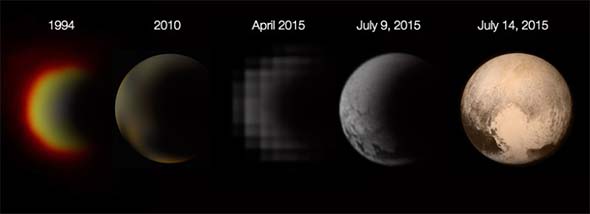
A history of the images of Pluto. [More]
f6f62fb4-6f44-4ad4-a4de-d1c9929d450e|1|5.0
Tags:Pluto, New Horizons, space, space probe, NASA, solar system, planet, dwarf planet, moon, water, Io, Clyde Tombaugh
This morning, the first step on the road to a manned mission to Mars was taken. NASA's Orion space capsule successfully completed its first dual-orbital test flight and splashed down in the Pacific Ocean.
The space craft finally launched this morning from Cape Canaveral Air Force base a little after 7 am Eastern time, after having been delayed for a day due to technical problems and poor weather. After a four-and-a-half-hour flight in which the spacecraft orbited the Earth twice at an altitude of 3600 miles, the capsule re-entered the atmosphere, deployed its parachutes, and landed gently in the Pacific Ocean.
This flight is the first step in a planned manned mission to Mars that is expected to take place within the next 25 years, assuming that it doesn't get derailed by political or monetary issues.
This is exactly the kind of mission that advocates argued would be encouraged by the termination of the space shuttle program. Critics argued that the space shuttle made access to earth's orbit too easy and reliable, and "tethered" NASA to low-earth orbit, instead of finding innovative new ways to reach further into space... [More]
ba8efa03-b9f9-484b-930e-b406ee908904|0|.0
Tags:Orion, NASA, National Aeronautics and Space Administration, science, Mars, orbit, space shuttle, Apollo, Cape Canaveral, SpaceX, China
|

| 12 | | | | | | | 60 | | 11 | | | | | | | 55 | | 10 | | | | | | | 50 | | 09 | | | | | | | 45 | | 08 | | | | | | | 40 | | 07 | | | | | | | 35 | | 06 | | | | | | | 30 | | 05 | | | | | | | 25 | | 04 | | | | | | | 20 | | 03 | | | | | | | 15 | | 02 | | | | | | | 10 | | 01 | | | | | | | 05 |
|